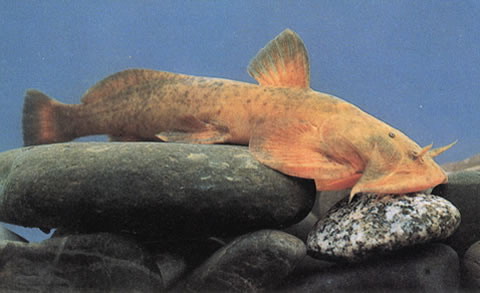| Sisoridae (Sisorid catfishes), subfamily: Glyptosterninae |
| 19.3 cm NG (male/unsexed) |
|
demersal; freshwater |
| Asia: China. Known only from the upper Min-Jiang (Yangtze River basin, China) (Ref. 86867). |
|
Dorsal spines (total): 1; Dorsal soft rays (total): 5; Anal spines: 1; Anal soft rays: 4-5. Euchiloglanis kishinouyei differs from E. longibarbatus by having a pointed maxillary barbel, not elongated as a thread, with the tip reaching only to the gill opening (vs. maxillary barbel elongated as a thread, with tip reaching posteriorly beyond gill opening. Euchiloglanis kishinouyei differs from E. davidi, E. longibarbatus and E. longus by lacking indentations in premaxillary tooth band (vs. with indentations). It differs from E. davidi by having the length of the pectoral fin being equal to 75.5–89.6% (vs. 90.5–117.1%) of distance between insertions of pectoral and pelvic fins and further differs from E. davidi and E. longus by having the distance between insertion of pelvic-fin and origin of anus being equal to 81.5–97.5% (vs. 100.0–125.0 and 108.9–140.6% respectively) of distance between insertions of pectoral and pelvic fins. Euchiloglanis kishinouyei differs from E. dorsoarcus and E. phongthoensis by having the anus located midway between the pelvic-fin insertion and the anal-fin origin (vs. the distance from the anus to pelvic-fin insertion equal to about 50% of the distance from the anus to the anal-fin origin) (Ref. 86867). |
| Inhabits rocky and gravel bed pools in streams (Ref. 12045). Found in mountain rapids (Ref. 41236). |
|
Not Evaluated (N.E.) Ref. (130435)
|
| harmless |
Source and more info: www.fishbase.org. For personal, classroom, and other internal use only. Not for publication.

